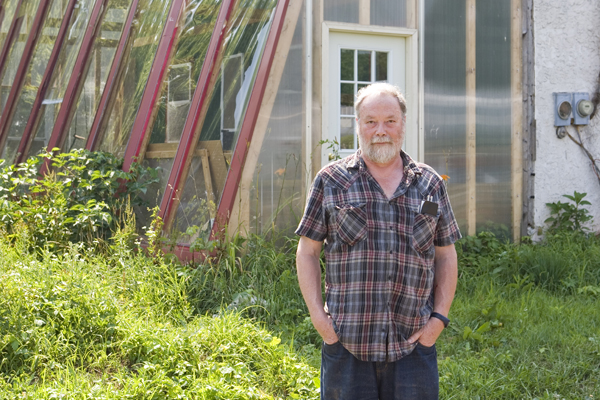 Nick Pine pushes solar power that goes beyond panels
Nick Pine pushes solar power that goes beyond panels
by Lee Stabert
“Solar power” conjures images of high-tech, high-priced panels and carefully constructed rigs, but, as Nick Pine explains, the concept is actually much simpler—harnessing the sun’s heat can be cheap and easy, and an excellent replacement for fossil fuels.
Pine has an eclectic résumé, but he is obviously a problem-solver at heart. After a childhood spent in Wayne, he studied at Cornell before earning a Masters in electrical engineering from Villanova. He has worked for aerospace companies and Western Union. He is also a registered US Patent agent, passing the federal patent bar exam without a law degree. These days, he lives on a farm in Collegeville, growing food on five acres (including two high tunnels for tomatoes) and talking to anyone who will listen about inexpensive, effective energy-saving methods.
When Nick Pine talks about solar power, he’s talking about solar heating, not solar electricity. His current passion is sunspaces—small external rooms where air is heated by the sun, and then circulated throughout the house. He heats his 1820 stone farmhouse with a sunspace. “I’m trying to point out to people that solar heat can be 100 times less expensive than solar electricity and that houses need about three or four times more heat energy than electrical energy,” explains Pine. “And by solar heat, I don’t mean solar panels on the roof, I mean a little sun room where the sun shines in and heats up the air and the air moves through the house, and at night the airflow stops and thermal mass in the house keeps it warm.”
For his sunspaces, Pine uses panels made of thin polycarbonate plastic, inflated with dry air (or argon gas, when available). The cost per square foot is between $5 and $10. Each square foot provides the heat equivalent of about a gallon of oil per year. You can also make hot water for showers.
But it’s summer, making it a bit tough to get worked up about a winter chill. Fortunately, Pine also has plenty of low-tech advice for staying cool. He claims that with a few smart, simple solutions (window fans, external and interior thermometers), Philadelphians can avoid the A/C for all but a couple weeks a year. “Look at your indoor thermometer and your outdoor thermometer,” explains Pine. “If, at 10:37 p.m. on Tuesday night, you notice it’s cooler outdoors, turn on your window fan. And, the next morning at 11:36 a.m., when you see that it’s warmer outdoors than it is indoors, turn off your window fan and close the windows. I don’t think anyone really does that. And it’s simple to do with a computer and some temperature sensors, which are fairly inexpensive these days.”
The American Society for Heating and Refrigeration Engineers (ASHRAE) has something called a comfort zone and a comfort scale, from minus 3 to plus 3. Zero is considered comfortable. The edges are defined by upper and lower temperatures, and upper and lower humidity limits. And for comfort, 80 degrees at about 60 percent humidity is livable. “It’s a little bit on the upper edge,” says Pine. “But if you’re trying to save energy, that’s a good target. Moving air helps, too; it can be even warmer in that case, or more humid.”
Pine has also been experimenting with humidity solutions—one with serious potential is kitty litter. “I’m trying to help an 87-year-old friend in Harleysville whose dehumidifier is running full-time in the basement,” says Pine. “That’s about $2 a day for electricity. Turns out, if you cover the floor of your sunspace with cat litter, it absorbs moisture at night and during the day the sun bakes out the moisture—the next day it’s ready to absorb moisture again. Two hundred pounds of cat litter would do an average-size house around Philadelphia.” Not quite as glamorous as those shiny panels, but effective nonetheless.




Dear Mr, Lee Stabert,
my name is Bjorn and I am working on a school project and desperatly trying to get in touch with Mr Pine,
however all his email adresses on his science papers seem not to work.
I was calling his company, but also no luck here.
I wonder if you could bring me in touch with Mr Pine?
My email address is
depepe@gmail.com
Many thanks for your time
Regards
Bjorn